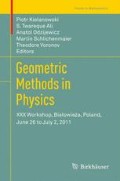Abstract
Dynamical differential equations, like the Schrödinger equation for the states, or the Heisenbergequa tion for the observables, need to be solved under boundary conditions. The original boundary condition of von Neumann, the Hilbert space axiom, required that the allowed wave functions are Lebesgue square integrable. This leads by a mathematical theorem of Stone-von Neumann to the unitary group evolution meaning the time t extends over \( -\infty\,<\,t\,<\,+\infty \). Physicists do not use Lebesgue integrals but followed a different path usinga lmost exclusively the Dirac formalism and well-behaved (Schwartz) functions. This led the mathematicians to Schwartz- Rigged Hilbert spaces (Gelfand triplets), which are the mathematical core of Dirac’s bra-ket formalism. This is insufficient for a theory that includes resonance and decay phenomena, which requires analytic continuation in energy E in order to accommodate exponentially decayingG amow kets, Breit-Wigner (Lorentzian) resonances, and Lippmann-Schwinger kets. This leads to a pair of Rigged Hilbert Spaces of smooth Hardy functions, one representing the prepared states of scatteringe xperiments (preparation apparatus) and the other representingd etected observables (registration apparatus). A mathematical consequence of the Hardy space axiom is that the time evolution is asymmetric given by the semi-group, i.e., \( t_0\,\leq\,t\,<\,+\infty \), with a \( t_0 \). What would the meaningo f that \( t_0 \) be?
Mathematics Subject Classification (2010). 81-06; 81P16; 81R99; 34L10.
Access this chapter
Tax calculation will be finalised at checkout
Purchases are for personal use only
Preview
Unable to display preview. Download preview PDF.
References
M.H. Stone, Ann. Math. 33(3), 643 (1932); J. von Neumann, Ann. Math. 33(3), 567 (1932).
P. Dirac, Proc, Roy. Soc. 113 (1932), 621–641; P. Dirac, The Principles of Quantum Mechanics, 4th Edition, Oxford University Press, Oxford, 1958.
L. Schwartz, Théories des distributions, 1st edition, Hermann, Paris, 1950.
A. Bohm, The Rigged Hilbert Space and Quantum Mechanics, Springer Lecture Notes in Physics, vol. 78 (1978).
I.M. Gelfand and N.Ya. Vilenkin, Generalized functions, Vol. 4, 1st edition, Academic Press, New York, 1964; K. Maurin, Generalized Eigenfunction Expansion and Unitary Representations of Topological Groups, 1st edition, Polish Scientific Publishers, Warszawa, 1969; S.L. Sobolev, Math. Sbornik 1(43) 1936, 39–72; S.L. Sobolev, Some Applications of Functional Analysis in Mathematical Physics, Leningrad, 1950; A. Grothendieck, Memoirs Amer. Math Soc., Nr. 16, Providence, RI 1966; J.P. Antoine and C. Trapani, Partial Inner Product Spaces, Lecture Notes in Mathematics, Springer Verlag Berlin, 2009
A. Bohm and M. Gadella, Dirac Kets, Gamow Vectors and Gelfand Triplet, Lecture Note in Physics, vol. 348, Springer, Berlin, 1989.
R.G. Newton, Scattering Theory of Waves and Particles, 2nd edition, Springer, New York, 1982. See also J.R. Taylor, Scattering Theory, John Wiley & Sons, June (1972)
B.A. Lippmann and J. Schwinger, Phys. Rev. 79 (1950), 469–480, 481–486. M. Gell- Mann and H.L. Goldberger, Phys. Rev. 91 (1953), 398–408. K. Gottfield, Quantum Mechanics, Benjamin, Inc, New York, 1966.
A. Bohm, Quantum Mechanics, section XXI.4, 1st edition (1979) pp. 492–496; 2nd edition (1986) pp. 549–567 or 3rd edition (2001) and later paperbacks.
A. Bohm: Lett. Math. Phys. 3, 455 (1979) J. Math. Phys. 26, 2813–2823 (1981).
H. Baumgartel, Math. Nachrichten 75 (1976), 133–151.
P.L. Duren, ℋ 𝑃 -Spaces, Academic Press, New York, 1970; P. Koosis, Introduction to ℋ 𝑃 Space, London Mathematical Society, Lecture Notes Series Vol. 40 (Cambridge University Press, Cambridge, 1980).
O. Civitarese and M. Gadella, Physics Report, 396 (2004), 41; Sect. 3.1.
Y. Strauss and L.P. Horwitz and E. Eisenberg, J. Math. Phys. 41, No. 12, 8050 (2000).
Y. Strauss, Int. J. Theor. Phys. 42, 2285 (2003).
Y. Strauss, L.P. Horwitz, and A. Volovick, J. Math. Phys. 47, 123505 (2006).
E.P. Wigner, Symmetries and Reflections, Indiana University Press, 1967; Ox Bow Press Woodbridge, Connecticut, 1979.
R. Paley and N. Wiener, Fourier Transform in the Complex Domain, American Mathematical Society, New York, 1934.
P.D. Lax and R.S. Phillips, Scattering theory, 1st edition, Academic Press, New York, 1967.
H. Baumgärtel, Int. J. Theor. Phys. 46, 1959 (2007).
H. Baumgärtel, J. Math. Phys. 51, 113508 (2010).
See also H. Baumgärtel, Review in mathematical Physics, 18, 61 (2006).
Author information
Authors and Affiliations
Corresponding author
Editor information
Editors and Affiliations
Rights and permissions
Copyright information
© 2013 Springer Basel
About this paper
Cite this paper
Bohm, A., Bui, H.V. (2013). The Marvelous Consequences of Hardy Spaces in Quantum Physics. In: Kielanowski, P., Ali, S., Odzijewicz, A., Schlichenmaier, M., Voronov, T. (eds) Geometric Methods in Physics. Trends in Mathematics. Birkhäuser, Basel. https://doi.org/10.1007/978-3-0348-0448-6_17
Download citation
DOI: https://doi.org/10.1007/978-3-0348-0448-6_17
Published:
Publisher Name: Birkhäuser, Basel
Print ISBN: 978-3-0348-0447-9
Online ISBN: 978-3-0348-0448-6
eBook Packages: Mathematics and StatisticsMathematics and Statistics (R0)

